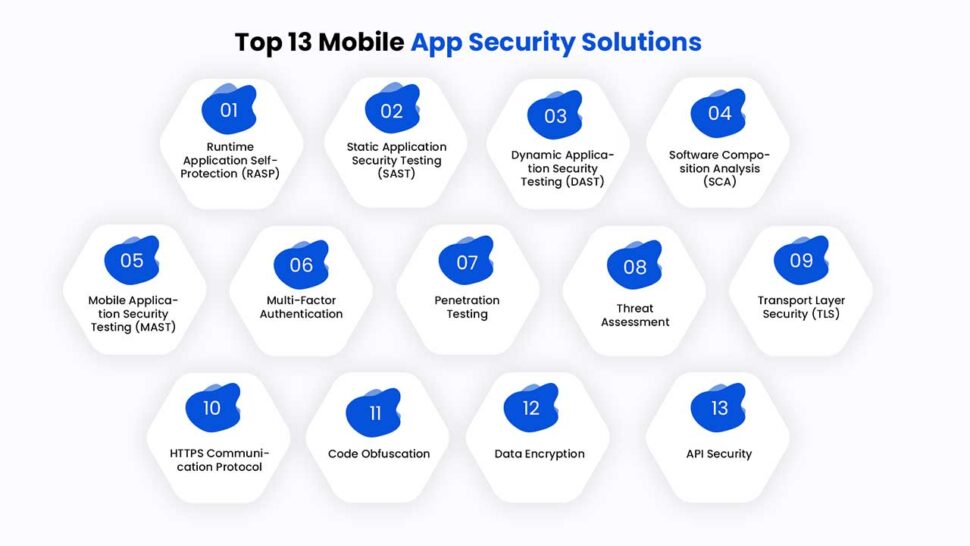Some of the widely recommended types of mobile application security solutions like source code encryption, RASP, SAST, DAST, IAST, MAST, penetration tests, backend security, API security, data encryption/cryptography, and authentication security allow app developers to safeguard mobile applications from many security threats.
But are they all necessary?
Yes, they are.
A mobile app is always vulnerable to many security threats like SQL injection attacks, hacking, spyware, viruses, trojans, code injections, Cross-site Scripting (XSS) Attacks, Denial of Service (DoS) Attacks, reverse engineering, and Man-in-the-middle (MITM) Attacks.
Some examples:
Compromising user data to theft or other cybersecurity attacks leads to customer defections and a bad brand image. The examples mentioned below are some of the biggest instances of user data leaks that happened through applications.
Toyota’s 5-year Long Data Leak
In conclusion, irresponsible actions in source code management led to the leak of private information that customers believed to be safe within the app.
Cash App Data Theft
In 2022, a former employee of the parent company of Cash App stole reports that contained names and broker account numbers/unique identification numbers (UIN) of over 8.2 million US customers using the Cash App. Some stolen information also involved brokerage portfolio value and brokerage portfolio holdings. Such security threats remove any chances of customer loyalty or trust toward your app and brand.
Additionally, these security attacks can compromise organizational data, which could lose your business a lot of money and clients. For example, a fintech or healthcare application includes sensitive data regarding financial and healthcare institutions besides user data. This type of data can compromise regular operations and business if it falls into the wrong hands or gets leaked.
That is why you must identify every security vulnerability in your application and deal with it before you conduct any business through it. Not meeting privacy and security requirements can also lead to non-compliance with EU General Data Protection Regulation (GDPR) and financial standards like PCI Data Security Standards (PCI DSS).
Some common security vulnerabilities in mobile applications include:
- weak data encryption or cryptography
- insecure user authentication
- few or no security updates
- security misconfigurations
- server-side vulnerability
- open cloud storage
- insufficient transport layer protection (TLS)
- broken access control
- outdated components, and
- insecure APIs.
To avoid and deal with these vulnerabilities or problems caused by them, you need tested and recommended security solutions designed to safeguard user and organizational data/privacy.
Top 13 Mobile App Security Solutions
To get started, following most security and privacy guidelines on Apple App and Google Play store should help you understand the level of security you need to create inside your mobile application. Additionally, there are some effective app testing protocols and the best security solutions required for your mobile application.

Top 13 Mobile App Security Solutions
- Runtime Application Self-Protection (RASP)
- Static Application Security Testing (SAST)
- Dynamic Application Security Testing (DAST)
- Software Composition Analysis (SCA)
- Mobile Application Security Testing (MAST)
- Multi-Factor Authentication
- Penetration Testing
- Threat Assessment
- Transport Layer Security (TLS)
- HTTPS Communication Protocol
- Code Obfuscation
- Data Encryption
- API Security
Runtime Application Self-Protection (RASP)
Runtime Application Self-Protection (RASP) technology helps evaluate user behavior and app traffic while safeguarding an app from cyber attacks by revealing all the vulnerabilities. It helps identify and avoid cyber security threats by increasing visibility in the source code and evaluating all vulnerabilities. RASP can also integrate its system with the application and monitor, detect, and report any interaction or behavior by attackers.
It closely monitors and evaluates all new and incoming outside interactions inside the application to ensure it is well-protected from security threats.
Static Application Security Testing (SAST)
SAST tools help monitor the internal system of an application (such as the application source code) to detect any security vulnerabilities. This solution makes it easy to find input validation, coding, and syntax errors. The only problem with Static Application Security Testing is that it can only find security vulnerabilities inside the source code of an application, making it useless for security threats related to third-party solutions/libraries/APIs (which are highly common).
Dynamic Application Security Testing (DAST)
Dynamic Application Security Testing (DAST) tools help inspect the application code to identify security vulnerabilities. You may use DAST tools to detect authentication errors, risky third-party elements, query strings, data injection, and DOM injection. However, you must discuss the requirements of solutions like DAST with your developers and app security experts before using them as they may not always be necessary.
Software Composition Analysis (SCA)
Software Composition Analysis (SCA) makes it easy to prepare a library of third-party (open-source) elements utilized inside the application. It allows security experts and developers to identify factors that lead to security vulnerabilities in the app. Open-source elements are now one of the primary causes of security threats in mobile applications, and SCA tools can help you keep your app safe from that.
Mobile Application Security Testing (MAST)
Mobile Application Security Testing (MAST) tool allows developers to test mobile app security with dynamic and static analysis. It helps inspect and detect security threats posed by data that a mobile application collects. In short, identifying potential security weaknesses and data leakage vulnerabilities in mobile apps becomes possible with MAST. It can also simplify dealing with cyber security threats in a mobile application since it does not need a source code to do its work.
Multi-Factor Authentication
Multi-Factor Authentication provides more security to the login process of users by asking them for an additional secret code or an OTP to access their accounts inside our application. It prevents single weak passwords that hackers can easily guess to access user accounts. The second authentication code is usually sent through SMS, email, or Google authenticator to ensure the original users access their accounts.
Penetration Testing
Penetration testing enables developers to test and identify security vulnerabilities inside an application that would allow hackers to compromise the data and privacy of your app. The process evaluates vulnerable unencrypted data, risky third-party solutions, weak password policies, and so on to identify and deal with factors that can leave your app vulnerable to cyber security threats.
Regular penetration testing helps check the security of and from the perspective of potential hackers and increases the overall security of your application. It is one of the most effective application security types you can use to safeguard your app.
Threat Assessment
Making a detailed list of threats your app can face makes it easy to prepare for such threats and safeguard your app from them. You must understand how a hacker would think or which third-party elements could compromise your system. Generally, applications with weak firewalls are always at risk of hacking and breaches, leading to leaks of confidential data, payment details, and passwords. But even a secure app can always be vulnerable to numerous threats that are usually identified too late (after the attack).
Therefore, you must consult with an app security expert to identify vulnerabilities and determine how many security solutions your app needs.
Transport Layer Security (TLS)
TLS is a cryptographic solution that provides security for data shared between applications on the internet. It is most familiar to users through its use in secure web browsing and the padlock icon that appears in web browsers when there is an established secure session. However, it can prove helpful for actions like file transfers, instant messages, and video/audio calls.
Without TLS, sensitive information such as logins, credit card details, and personal details is easy to hack into and steal. It also makes monitoring private chats, electronic mail, and browsing behavior easier. By enabling client and server applications to support TLS, you can ensure that data transmitted between them is encrypted with secure algorithms and not viewable by third parties.
HTTPS Communication Protocol
Hypertext Transfer Protocol Secure (HTTPS) provides a network with data security protection during transmissions. Transport Layer Security (TLS) enables the encryption of such communication protocols. Also, cryptographic solutions like Secure Socket Layer (SSL certificate) and TLS help ensure data security/privacy in the communication mediums of your applications.
Code Obfuscation
Code Obfuscation is an effective protection method for your app to protect it from hackers and various security threats. It allows developers to create a complex version of the application code that is nearly impossible to understand for hackers. Obfuscation can turn any programming code into a completely different language that is not understandable by anyone and protects your app from attacks.
The solution includes limited or full code encryption, removes revealing metadata or APIs, and prevents hackers from guessing classes/variables by renaming them.
Data Encryption
Data encryption is a process where you encode application information and turn it into an encrypted format, which can only be accessed, read, or used with the correct encryption key. The encrypted information/data cannot be stolen or understood by hackers without the key, preventing unauthorized individuals from accessing the original content of your data.
Such encryption can protect all types of data like financial, government, and healthcare, data that could create legal, personal, and financial risks for businesses and people if stolen, lost, and leaked. Incorporating data encryption into the development process allows you to protect your application data from such threats. Any data storage and transmission in your app will be secure once all the data is safely encrypted.
API Security
Poor authentication and excessive data exposure are the common vulnerabilities in API. And APIs with few or multiple security vulnerabilities can lead to data breaches and leaks. Like most security issues, they can also cause legal and financial issues by leaking sensitive data and disrupting the regular operations of a business. Therefore, you must ensure that the APIs you use inside the application are well-protected with the best application security tools. It will help you safeguard the app from security threats/vulnerabilities caused by insecure APIs.
Top 10 Tools for App Security Testing
Keeping your application secure from cyber security threats would require tools that are up to date with changing and new security requirements of a mobile application. Below mentioned are some of them for you to check out and choose for your app:
- Mobile Security Framework (MobSF)
- WhiteHat Security
- ImmuniWeb® MobileSuite
- QARK
- Androguard
- DataDome
- HCL AppScan
- AppSweep
- TestFlight
- Xcode
Consult with your app security experts and developers frequently to choose the most suitable security systems for your app. And remember to update and replace the security system from time to time as it would prevent vulnerabilities in your app security solutions caused by outdated or weak security systems.
Conclusion
Securing a mobile application from security threats requires a lot of penetration testing and advanced app security tools. The first step in that process is hiring experienced app developers, QA engineers, and testers. Developers will ensure a better source code, while QA engineers/testers manage all the security features required to stay safe from cybersecurity threats.
Development and testing is the most crucial stage in ensuring mobile app security and removing the need for many security tools. However, use as many types of application security tools as your experts recommend, especially if your app regularly stores and transfers sensitive data related to finance or healthcare. Leaving such data vulnerable even for a second can lead to many legal and financial problems for your business.
To learn more about which security protocols can better protect your app, talk to experts from an established mobile app development company for insightful guidance and assistance.
Frequently Asked Questions
Mobile app security is about securing user data, privacy, and the application database from many cybersecurity threats like viruses, hacking, malware, and man-in-the-middle (MITM) attacks.
It helps app owners protect the data and privacy of their users and create a secure and convenient user experience for them, a factor necessary for an app to succeed and get a large user base.
Mobile apps are generally more secure than websites since websites usually have a lot more security vulnerabilities than mobile apps.
iOS apps are more secure than Android usually because iOS is a closed ecosystem, while Android is an open-source platform. Additionally, the security standards and tools provided by the Apple developer program are far superior to Google Play developer accounts.



















.png)
.png)
.png)



Leave a Comment